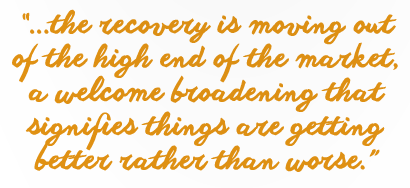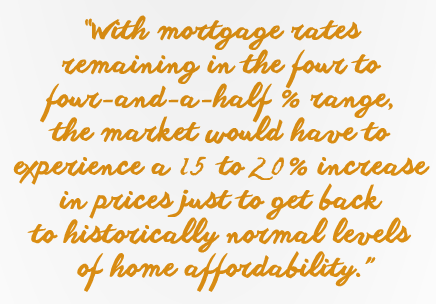U.S. housing market data has been sending mixed messages over the past year. On the negative side, existing home sales had been growing steadily since the start of 2015, but slumped sharply in August. Data from the Flow of Funds (FOF) shows outstanding mortgage debt has yet to rise in any meaningful way and, worse, median prices as reported by the National Association of Realtors appear to have fallen slightly in the last four months.
Single-family building permits have been rising slowly but remain far below normal levels, even as home ownership rates—as measured by the U.S. Census—unexpectedly fell at the start of the year. Concerns surrounding Federal Reserve policy and its impact on interest rates is also worrying investors.
With context, however, most of these issues become far more benign than they appear. In fact, it looks like the nation’s housing market will continue on its modest recovery path for at least the next couple of years.

Let’s start with the drop in ownership rates at the beginning of 2015, from 64.5 percent last year to 63.5 percent this year—the sharpest decrease since the peak of the housing crisis, according to the Census Bureau’s Housing Vacancy Survey (HVS). This appears to be an artifact rather than reality. This survey has been long criticized for its small sample and difficulty in finding appropriate benchmarks to create population estimates, problems that have led to large-scale historical revisions in the past.
The Census again modified their statistical techniques at the start of 2015, but this time they didn’t bother to reassess past estimates. As such, the numbers for 2014 and 2015 are not actually comparable. Recent numbers from another data source, the American Community Survey, suggest that the actual ownership rate in the U.S. last year was 63.1 percent, considerably lower than the initial HVS estimate. Importantly, this suggests that the correctly-calculated 2015 HVS numbers indicate homeownership is again on the rise—albeit at a slow pace and from a historically low level. But a rise is a rise.
According to the National Association of Realtors (NAR), the median price of an existing single-family home rose to $217,000 in 2015, up 4.7 percent from last year, but seemingly peaked a few months ago, and has since dropped to levels below where they were in January. This is out of sync with other price measures like the Case-Shiller and CoreLogic Home Price Indexes (HPI), which have shown home price growth accelerating in recent months. The explanation is that the median price does not control for sales. When the median price is flat compared to a quality-controlled HPI, it implies a shift to sales among lower end units. This suggests that the recovery is moving out of the high end of the market, a welcome broadening that signifies things are getting better rather than worse.
This conclusion is also supported by other sources. While it is clear that obtaining a mortgage is still relatively difficult, there are plenty of signs of a slow thaw in the market. The New York Federal Reserve has been releasing data on new mortgage originations in recent years. They report that in the second quarter of 2015 originations hit $465 billion, the best since the refinance boom of 2013. As for the aforementioned stagnant level of outstanding mortgage debt, this is largely an accounting issue as banks continue to slowly write off mortgage debt on homes that may have gone into foreclosure years ago.

As for who is lending, this too is beginning to expand. Fannie Mae and Freddie Mac are doing brisk work as can be seen in their profits. But banks are also starting to get back into the lending game. Small banks have increased their holding of home mortgages by seven percent over the last year, and credit unions have expanded theirs by almost 10 percent. Only the large banks are holding back. It remains difficult for those with low credit scores to get new mortgages, but better employment numbers and rising incomes have allowed many people who weren’t there just a few years ago to begin accessing mortgage lending markets.
Prices should also continue to rise, and although they have just climbed back to their peak prior to the meltdown, once we control for prices and interest rates it becomes clear that affordability remains better now than it has been at any time since 1996. With mortgage rates remaining in the four to four-and-a-half percent range, the market would have to experience a 15 to 20 percent increase in prices just to get back to historically normal levels of home affordability. There is no bubble in the market, at least not yet.
This could change, however, if interest rates start to rise sharply. The markets have been expecting the Federal Reserve to begin the tightening process for the last few months, and it was a surprise to many when their September meeting came and went without an increase. An increase is still expected by the end of the year, a view echoed by some on the Fed’s voting committee.
Nevertheless, it’s a mistake to think that Federal Reserve policy will have much of an impact on mortgage rates. Mortgage rates are typically tied to the 10-year treasury. Beacon Economics’ analysis of the relationship between the Federal Funds Rate (FFR) and the 10-year note is quite weak—about a one in 10 relationship. In other words, if the Fed pushes up the FFR by a full percentage point, then the 10-year would only go up by one-tenth of a point.
Remember that the Federal Reserve does not have a lot of room to maneuver. If they raise the FFR by 200 basis points (BPS) they would likely end up inverting the yield curve and causing massive market disruptions. Even if they begin this fall the increases will be small and far apart. Beacon Economics expects mortgage rates to remain under five percent for the foreseeable future.
Consider it all and it is clear that the U.S. housing market expansion still has legs. Expect single-family permits to continue their slow climb, up to 800,000 new units next year after a total this year of slightly over 700,000. Sales activity will also steadily increase as more households get back into the buying game.
Christopher Thornberg, PhD is Founding Partner of Beacon Economics LLC, www.BeaconEcon.com
To view the original article please see our magazine titled “Economic Growth” Vol 4, Issue 5 by Clicking Here

 Login
Login

